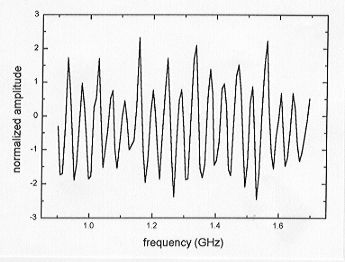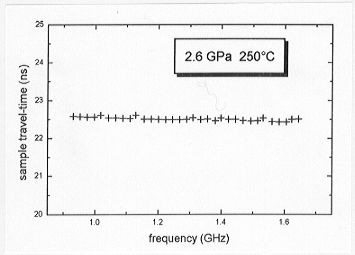

Seismologists require laboratory derived thermoelastic data on candidate minerals for interpretation of raw seismic velocities in the Earth. In particular, elastic constant data in conjunction with high-precision isothermal compression (bulk moduli) from X-ray diffraction provide equation of state parameters necessary for the extrapolation of laboratory data to deep Earth conditions for direct comparison with seismological observation.
In recent years, considerable progress has been made towards adapting the diamond anvil cell (DAC) for in-situ elastic property measurements and X-ray diffraction. Despite this success, ultrasonic measurements in the DAC at high temperature still face two major challenges: 1) maintaining acoustic coupling between the sample and the diamond at high temperature in a liquid pressure medium; and 2) measuring pressure changes in the cell induced by high temperature. Recently, we maintained an acoustic coupling between the buffer-rod/diamond assembly and a natural olivine sample at modest conditions of 2.6 GPa and 250°C in an ethanol-methanol pressure medium, although we cannot yet directly measure the pressure at high temperature.
High temperatures are achieved by two independently controlled Mo-wire
resistance heaters in contact with the tungsten-carbide seats. Temperature
is measured by a pair of chromel-alumel thermocouples attached to the lower
and upper diamonds. The DAC frame and diamonds are cooled by a directed
stream of argon gas. We cut and polished (perpendicular to [001]) discs
of single-crystal San Carlos olivine (Fo89) measuring 200 µm in diameter and 90 µm thickness. One of these
discs was loaded in an ethanol-methanol mixture pressure medium and brought
to 2.0 GPa at room temperature (measured by ruby-fluorescence). No bonding
agent between the sample and the diamond anvil was required to achieve
coherent transmission of acoustic energy. We made several heating excursions
up to 200ºC and found that the acoustic coupling to the sample was
maintained at these temperatures. Next, we increased the pressure to 2.6
GPa and measured round trip P-wave travel times through the sample at 25,
100, 150, and 250°C. Figure 3.8-4 shows
the interference amplitude versus frequency for acoustic waves reflected
at the buffer-rod/diamond interface and from the free end of the sample
at 2.6 GPa and 250°C. The reduced travel
time data for this experiment are plotted in Fig. 3.8-5.
 |
Fig. 3.8-4: Reduced interference amplitude data for olivine
at 2.6 GPa and 250°C. This plot illustrates that the interference between
two acoustic wave packets reflected from the buffer rod/diamond interface
and the free end of the sample are still measurable at high temperature. |
 |
Fig. 3.8-5: Plot of the round-trip travel time (ns) through
the olivine sample as a function of frequency (GHz), measured at 2.6 GPa
and 250°C. |

Tel: +49-(0) 921 55 3700 / 3766, Fax: +49-(0) 921 55 3769, E-mail: bayerisches.geoinstitut(at)uni-bayreuth.de
 Previous page
Previous page